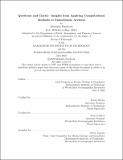Questions and Clarity: Insights from Applying Computational Methods to Paleoclimate Archives
Author(s)
Fendrock, Michaela
DownloadThesis PDF (9.961Mb)
Advisor
McGee, David
Condron, Alan
Terms of use
Metadata
Show full item recordAbstract
It is a scientifically accepted fact that the Earth’s climate is presently undergoing significant changes with the potential for immense negative impacts on human society. As evidence of these impacts become clear and common, it becomes ever more important to constrain the nature, magnitude, and speed of changes to Earth systems. A fundamentally important tool to this understanding is the Earth’s past, recorded in the geologic record. There, lie examples of climate change under various forcings: important data for understanding the fundamental dynamics of climate change on our planet. However, when a climate signal is written in the geologic record, it is coded into the language of proxies and distorted by time. This thesis endeavors to decode that record using a variety of computational methods on a number of challenging proxies, to draw more information from the climate past than has previously been possible. First, machine learning and computer vision are used to decipher the primary, centimeter-scale textures of carbonate deposits in Searles Valley and Mono Lake, California. This work is able to connect facies in the tufa at Searles, grown during the Last Glacial Period, and those forming presently at Mono Lake. Next, the tracks of icebergs purged during Heinrich Events are simulated using the MIT General Circulation Model. This work, running multiple experiments exploring different aspects internal and external to the icebergs, reveals wind and sediment partitioning as centrally important to the spatial extent of Heinrich Layers. Each of these works considers a traditional geologic archive – a carbonate facies, a marine sediment layer – and uses computational methods to approach that archive from a different perspective. By applying these new methods, more information can be gleaned from the geologic record, building a richer narrative of the Earth’s climate history. The final chapter of this thesis discusses effective teaching and strategies for building communities to support teaching practice in Earth Science departments.
Date issued
2022-05Department
Massachusetts Institute of Technology. Department of Earth, Atmospheric, and Planetary SciencesPublisher
Massachusetts Institute of Technology